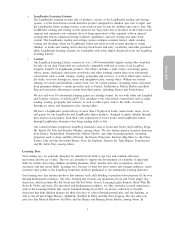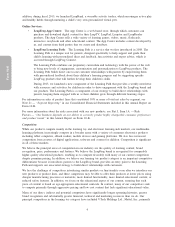LeapFrog 2015 Annual Report Download - page 20
Download and view the complete annual report
Please find page 20 of the 2015 LeapFrog annual report below. You can navigate through the pages in the report by either clicking on the pages listed below, or by using the keyword search tool below to find specific information within the annual report.
Our liquidity may be insufficient to meet the long-term or periodic needs of our business.
In addition to cash received from the collection of accounts receivable, from time to time, we may fund our
operations and strengthen our liquidity through borrowings under our line of credit. Our line of credit has
numerous financial tests and covenants that affect the amount we can borrow, and includes various events of
default that could impair our ability to access credit under the credit line. In addition, continued operating
losses over an extended period of time may render our cash plus borrowing availability under our line of
credit insufficient to fund operations at current levels. Any impairment of our ability to access, or extend the
term of, our credit line could increase our cost of capital or limit our ability to secure additional capital to
fund our operations should we need it and materially impact our financial results and operations.
If we were required to record an impairment charge related to the value of our long-lived assets, or an
additional valuation allowance against our deferred tax assets, our results of operations would be
adversely affected.
Our long-lived assets are tested for impairment if indicators of impairment exist. If impairment testing shows
that the carrying value of our long-lived assets exceeds their estimated fair values, we would be required to
record a non-cash impairment charge, which would decrease the carrying value of our long-lived assets, as the
case may be, and our results of operations would be adversely affected. For example, for the fiscal year ended
March 31, 2015, we recorded a $19.5 million impairment charge against our goodwill and a $36.5 million
long-lived assets impairment charge against our property and equipment. We will continue to review the
recoverability of our remaining long-lived assets on a quarterly basis, which may result in additional
impairment charges in future periods. Our deferred tax assets include net operating loss and tax credit
carryforwards that can be used to offset taxable income and reduce income taxes payable in future periods.
Each quarter, we determine the probability of realizing the benefits of our deferred tax assets. If we determine
that there is not sufficient anticipated future taxable income to realize the benefits of these assets, an additional
valuation allowance would be required to reduce the value of our deferred tax assets. Such a reduction could
result in additional non-cash expense in the period in which the valuation allowance is adjusted and our
results of operations would be adversely affected. For example, for the year ended March 31, 2015, we
recorded a $90.8 million income tax provision as a result of establishing an additional valuation allowance
against our domestic deferred tax assets. We will continue to perform these tests and any future adjustments
may have a material adverse effect on our financial condition and results of operations.
Our business is highly seasonal, and our annual operating results depend, in large part, on sales relating
to the brief holiday season.
Sales of consumer electronics and toy products in the retail channel are highly seasonal, causing a substantial
majority of our sales to retailers to occur during the quarters ending September 30 and December 31.
Approximately 76% and 73% of our total net sales occurred during the six months ended December 31
of years ended March 31, 2015 and 2014, respectively; and approximately 70% and 75% of our total net sales
occurred during the second half of the years ended December 31, 2013 and 2012, respectively. A decline of
net sales, in the quarter ending September 30 or December 31 in particular, will have a disproportionate
negative impact on our results for the year and can lead to ongoing weakness in sales to retailers well into the
following year. Therefore, we may be significantly and adversely affected, in a manner disproportionate to the
impact on a company with sales spread more evenly throughout the year, by unforeseen events such as
economic crises, strikes, earthquakes, terrorist attacks or other catastrophic events that harm the retail
environment or consumer buying patterns during our key selling season.
Significant increases in the cost of our components and raw materials or an inability to obtain these in
sufficient quantities from our suppliers or alternative sources could negatively impact our financial
results.
Because some of the components used to make our products currently come from a single or a limited number
of suppliers, we are subject to significant supply and pricing risks. Many components that are available from
multiple sources are at times subject to industry-wide shortages and significant commodity pricing
fluctuations. If our suppliers are unable to meet our demand for components or raw materials and we are
unable to obtain an alternative source or if the price available from our current suppliers or an alternative
13
























